THURSDAY
JANUARY 30 - 2014
BROOK
MEADOW
Flooding
news
I went over to the
meadow this morning to check on the state of the river
bank in the north-east corner. The remaining sandbags
had been rearranged more neatly along the edge of the
river bank, presumably by the Environment Agency.
However, I don't think any of the bags had been
retrieved from the river. The level of the river was a
bit lower than it was yesterday as is the flood water
in the south meadow.
Bird
song
I was very pleased to
hear the song of a Blackbird from the top of one of
the Crack Willow trees on the river bank to the south
of the north bridge, the first of the year on Brook
Meadow. I listened to its rich song for a couple of
minutes; it was not the full summer song, but probably
a sub-song. Other birds singing included Robin,
Dunnock, Wren and Great Tit, but I have yet to hear
Chaffinch and Blue Tit this winter.
Carrion
Crows
It is not unusual to
see our resident pair of Carrion Crows foraging around
on the grassland of Brook Meadow, particularly during
this very wet weather. However, today, Chris Oakley
watched a pair of Crows feeding on a carcass of what
he is fairly sure was a Brown Rat and not a Water
Vole.
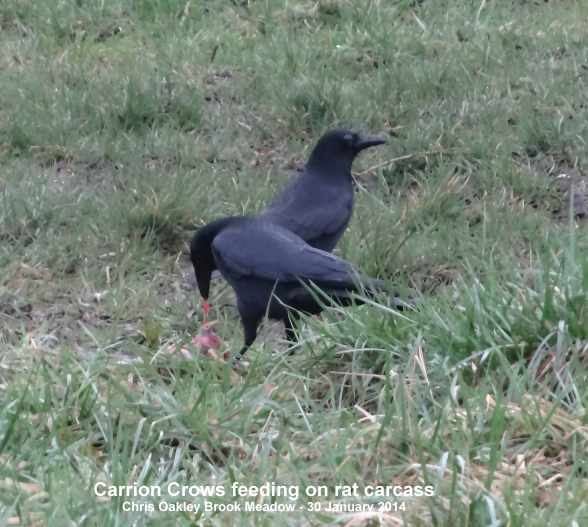
Emsworth
Millpond and Harbour
Peter Milinets-Raby
took a walk around the town millpond where he saw a
female Red Breasted Merganser actively feeding.
I have had this bird reported by a couple of other
people, but I have not seen it myself, despite walking
round the pond almost daily!
In the eastern harbour
(1:40pm to 2:20pm) Peter counted an impressive flock
of 686 Knot from 5 photos he took of the birds.
Here is one of the photos showing about 204 of the
birds. Large flocks of Knot are not unusual in
Emsworth Harbour at this time of the year, though this
is certainly the largest flock reported so far this
winter.
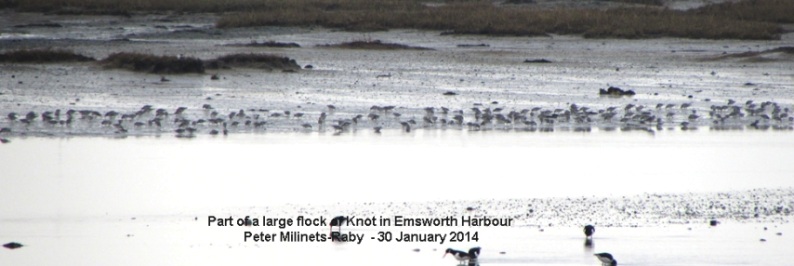
Peter also saw
colour-ringed Greenshank G-R/BtagN which was
probably one of those newly tagged on Thorney Island
on Jan 18. I have asked him to report it to Anne de
Potier who is keeping the Greenshank colour-ringed
data base.
Harbour
Seals
The report from
Juliette Leach on Jan 27 about Seals actively pursuing
her dinghy reminded Ralph Hollins of a similar
anecdote from the distant past. He says, "It described
how someone was fishing (I think using a net) from a
dinghy in the Sweare Deep channel near the entrance to
Northney Marina when a Seal decided to help itself to
the fish he caught and it showed a similar
fearlessness in coming right up to the stern of the
dinghy, forcing the fisherman to abandon his fishing
expedition. More recently I have heard reports of
Seals in Langstone Harbour swimming underwater, coming
up below wildfowl, seizing them by the legs and
tossing them in the air - whether they actually eat
them (they are not equipped to pluck the birds) or
just do it for fun I do not know."
Here is a photo of a
typical group of Seals hauled up on the mudflats on
Thorney Island taken by Richard Somers Cocks a couple
of years ago.
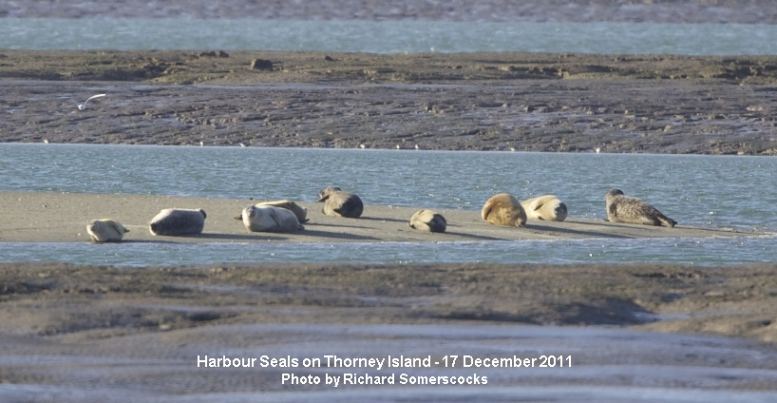
Regarding the number
of Seals in the local harbours, Ralph refers to the
Chichester Harbour Conservancy website at . . .
http://www.conservancy.co.uk/page/seals/375/
which says
that the current estimate of the total population in
the harbours is between 23 and 25 though no more than
18 have been seen together. The Conservancy do not
mention breeding, but they do refer to the harbours as
being the only 'Seal Rookery' (ie where they breed) in
the eastern English Channel.
WEDNESDAY
JANUARY 29 - 2014
BROOK
MEADOW
Flooding
news
I had a walk through
the meadow this morning. The river level was about the
same as in previous days and the flood in the south
meadow was also much the same. The sandbags that the
Environment Agency positioned along the river bank in
the north-east corner of the meadow have been thrown
into the river. This was sadly fairly predictable,
offering too much temptation to local lads. However,
Maurice Lillie informed me that Jennifer Rye succeeded
in replacing several of sandbags that she was able to
rescue from the river. These are the ones that can be
seen in the photo. Maurice praised Jennifer for the
effort that she puts in completely unsolicited and to
good effect. The Environment Agency have been made
aware of the situation and have said they will send
out a team to remove and replace them.
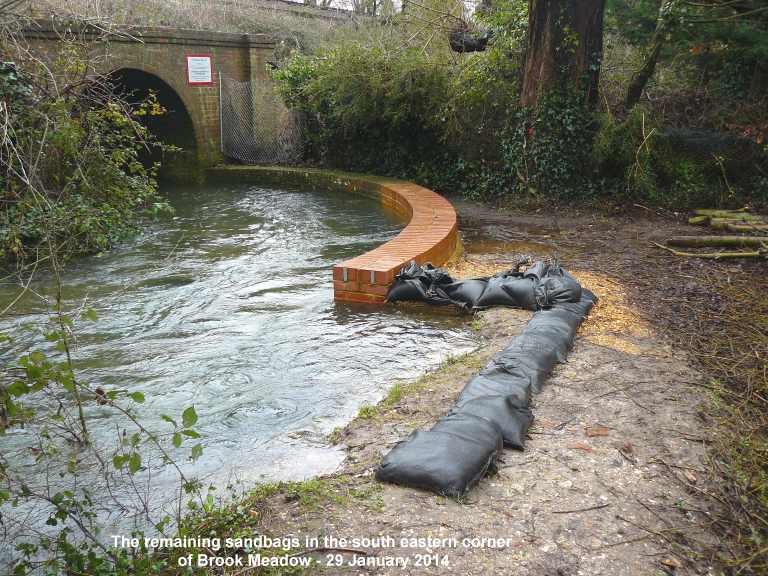
Wildlife
The first Primroses
are just opening on the path from Palmer's Road
Car Park to the south bridge. I spotted a fresh growth
of Jew's Ear fungus (Auricularia
auricula-judae) on dead branch in Palmer's Road
Copse near the car park. This is the second example of
this easily identifiable fungus I have seen recently,
the previous one was in Lumley Road on Jan 24.
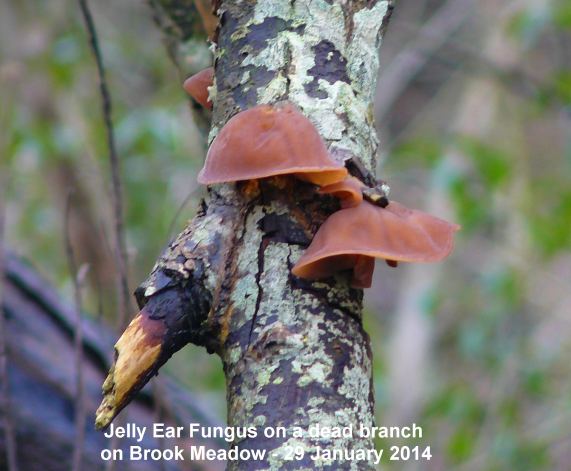
Other
news
Graham Petrie sent
this photo of a small flock of Goldfinches
enjoying the seed heads off pond grass in his garden,
completely ignoring the niger seed he had put out for
them! Given the choice, they will always go for the
natural foodstuff.
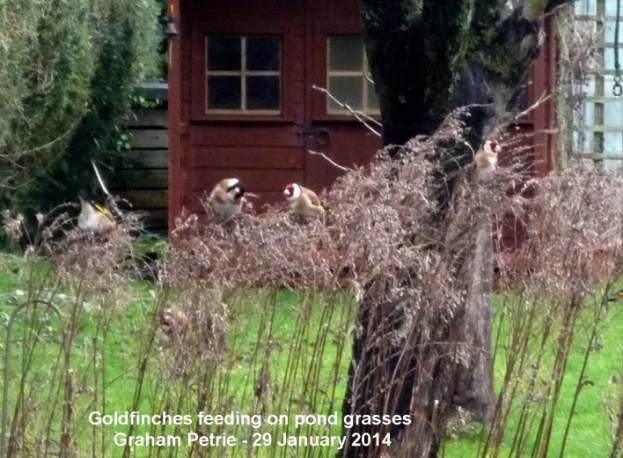
Graham tells me that
Hogboy the Hedgehog is doing very well but
still inside at present. Graham needs to sort out the
garage a bit before he put him out there, hopefully
this weekend.
Romney Turner got this
quick shot of a Short-eared Owl flying away
over Farlington Marshes earlier this week.
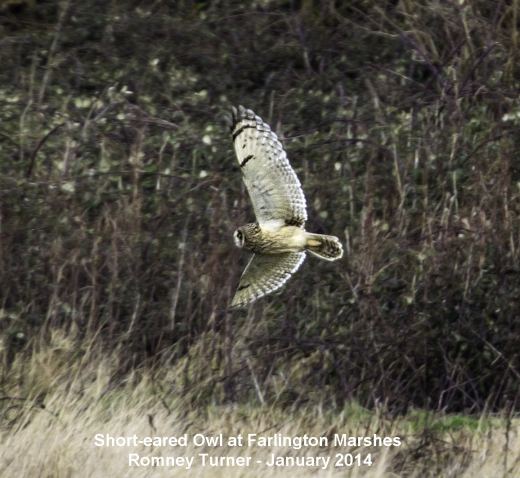
TUESDAY
JANUARY 28 - 2014
Hayling
beach
Chris Oakley was down
on Hayling beach on Monday where the gulls are still
feeding on the Whelk egg cases. He watched a Herring
Gull dropping and re-dropping a Limpet shell though
the wind kept carrying it back onto the soft grass, so
it gave up. Chris says there is a lot of restoration
work going on along the shore and vast amounts of
shingle are being piled along the top of the banks.
Chris noted a there
were lot of Pine cones washed up along the shore,
which he subsequently identified as Maritime Pine
cones. Native to the Mediterranean coasts, these
pines have been long grown in England, particularly in
southern England where they are known as Bournemouth
Pines. The cones are distinctive in that they grow in
groups of three facing back along the branch and are
very heavy.
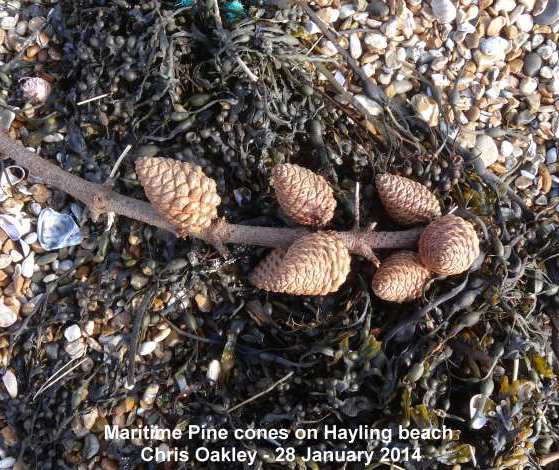
Water
Voles and flooding
Graham Roberts of the
Hampshire Wildlife Trust provided the following very
reassuring reply to my concerns about the effects of
the flooding on Brook Meadow on our Water Voles.
"At Winnall Moors near
Winchester, when the whole site was underwater for
some days, I waded through the reserve and found water
voles finding refuge in dense areas of bramble and
vegetation which was above the water line. This
re-enforces the need to always leave some dense
bankside vegetation along sections of river. This
obviously provides shelter for mammals during raised
water levels, stabilises banks , provides some shading
for rivers and potential cover and food for fish.
Water voles will happily feed on shredded bark from
young trees and shrubs when nothing else is
available."
Note: There is no
shortage of dense vegetation and brambles on the banks
of the River Ems for the voles to escape to, so
hopefully they should be OK.
Brook
Meadow funding
Maurice Lillie informs
me that at last evening's AGM of the Emsworth
Residents Association, the Brook Meadow Conservation
Group was awarded £500 from their Community Chest
Fund to go towards the purchase and installation of
the new tool store on the Seagull Lane patch.
MONDAY
JANUARY 27 - 2014
Nore
Barn
10:00 - I cycled over
to Nore Barn with the scope this morning to catch the
falling tide. Hard going along Warblington Road
against a stiff westerly. The Spotted Redshank was in
the stream when I arrived along with 6 Oystercatchers.
50+ Wigeon and a few Mute Swans were on the water. I
walked to the top of the creek where I found many more
Wigeon and some Teal and Brent Geese. A Common
Redshank was feeding on the shore. I met Roy Eames who
is concerned about the crumbling sea defences south of
the woods. When I got back to the stream, I found the
regular Spotted Redshank had been joined by its
friends, a second Spotted Redshank and a Greenshank;
all were unringed. The two shanks were feeding close
together and were clearly 'good friends'.
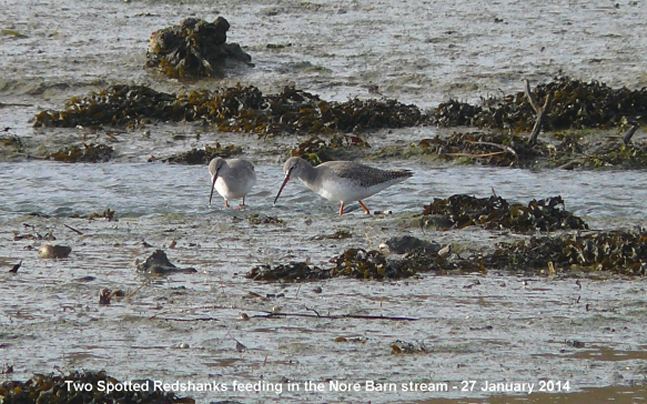
I walked back along
Western Parade checking the 200+ Brent Geese that were
feeding on the shore. No sign of the Black Brant. I
met Susan Kelly who told me she had seen a female
Red-breasted Merganser on the town millpond last
Friday - the first of the winter.
Brook
Meadow
I returned home
through the meadow where the river was still running
high, but no higher than before. Did not see anything
special in the way of wildlife. Maurice Lillie sent me
a few photos of the floods, including this one of the
south meadow looking north. It shows a dog walker
giving her dogs a bathe with the orange Environment
Agency fence in the background.
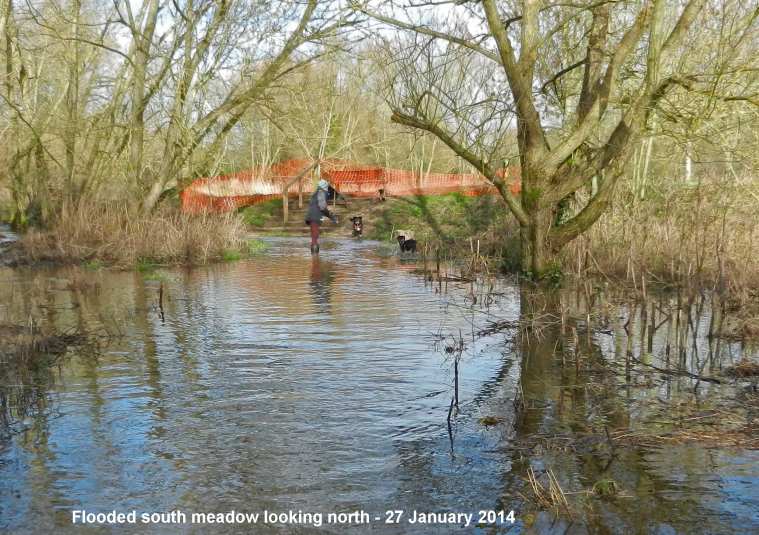
Memory
of Harbour Seals
The report from
Malcolm Phillips about seeing Harbour Seals during a
walk around Thorney Island on Saturday reminded
Juliette Leach about a wonderful encounter with them
this summer.
"My brother and I were
out sailing in our little dinghies on a calm and sunny
day from Emsworth up the west side of Thorney Island.
Just before we got to the large bay, we saw a couple
of seals playing and as we slowly sailed towards them,
they became very inquisitive and started playing and
jumping around our boats. The more we turned, the more
excited they got and as it was such a still, hot day
we could see them clearly under water. At one point, I
heard a noise at the stern and looked over to see one
of the seals was pushing me along with her nose on my
rudder! They also seemed to kiss each others noses
regularly! We must have played with them for a good 40
minutes before we went our separate ways. We went back
to see them again and although they were less playful
second time, they still came over to say
hello."
Garden
Blackcaps
Following my request
for more records of garden Blackcaps this winter,
Martin Hampton reported that he has had a female
Blackcap intermittently in his south Havant garden for
about six weeks, and a male Blackcap has become near
daily in the last week. Both feed on apples that
Martin sticks in trees and most especially on fat,
though nothing like as persistently or voraciously as
during last winter and early spring when his count
reached four individuals for a short time.
. .
. and Green Sandpipers!
Martin Hampton says he
also regularly sees a Green Sandpiper flying over his
garden from the Lymbourn stream. Usually it is one or
two, but once he had three! Martin is certainly a
lucky chap to have Green Sandpiper on his notional
from-the-garden list, and every year, too. Can anyone
else match that, I wonder?
Early
Bird Survey
The BTO have published
initial results for the Early Bird Survey (EBS)
earlier this month in which bird watchers were asked
to record the time when the first 10 species arrived
to feed in their gardens. They received 3,719
responses from almost 150 areas. Blackbird won the
crown of earliest bird, arriving, on average, 11
minutes after daybreak. It was closely followed by
Robin, Blue Tit, Dunnock and Magpie, all arriving in
the first 25 mins. The slowest of the common garden
birds to arrive at the feeders at an average of 44
mins after daybreak were Collared Dove and Greenfinch.
For the full list of results go to . . .
http://bto-enews.org/NXK-23BB6-3UEDCR-WABOA-0/c.aspx
SATURDAY
JANUARY 25 - 2014
Thorney
Island
Malcolm Phillips and
his friend walked right round Thorney Island today.
They saw some Harbour Seals wallowing on the mudflats.
I believe there are around 15 Harbour Seals in
Chichester Harbour in all.
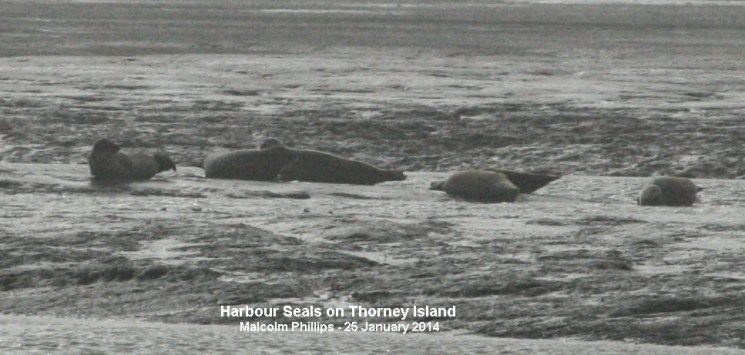
Malcolm also got this
photo of a female Stonechat which is a fairly common
bird around the coast at this time of the year.
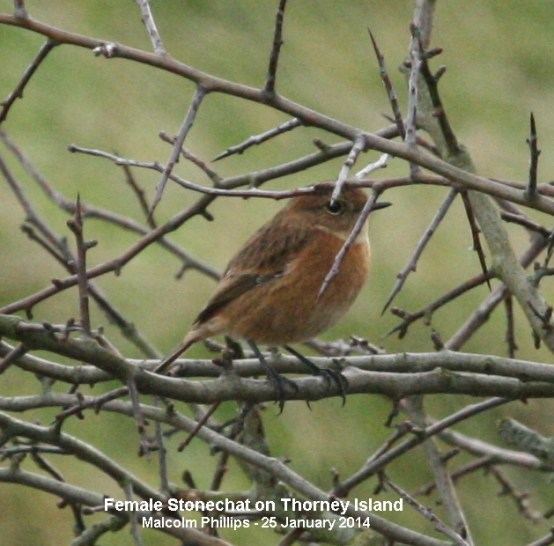
Grey
Heron in garden
Peter Milinets-Raby
snapped this fine Grey Heron which was perched on his
pagoda roof over looking the ponds, no doubt eyeing up
the goldfish. It stayed 10 minutes before it caught
Peter's movement at the window. I have seen a Grey
Heron on a neighbour's house roof also lining up the
fish in his pond.
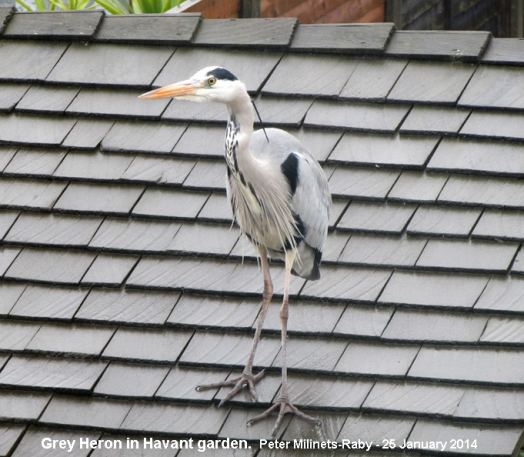
Hayling
Oysterbeds
Ros Norton reported on
this morning's walk by the Havant Wildlife Group.
"On a lovely sunny and
calm morning today 11 of us met at a low state of tide
and found the telescopes very useful as many birds
were a long way off. Highlights included 14 Black
Necked Grebe at the end of the walk, Goldeneye,
including males displaying, a distant Long-tailed
Duck, Mergansers , Great Crested and Little Grebes.
Brent Geese flew
overhead also on the mud and Shelduck close with
distant Gadwall and Wigeon. There were many waders
including Black-tailed Godwits, Redshank, Dunlin, Grey
Plover, Oystercatchers, Turnstones, and Little Egrets.
A Wren sang and a flock of Goldfinches flew past. A
pleasant surprise along the Hayling Billy line was a
large number of flowers on Sweet Violets."
FRIDAY
JANUARY 24 - 2014
Railway
Wayside
I had a look around
the wayside to the north of Emsworth Railway Station.
It looks as if the construction work along the track
to the north of the wayside is complete. However, the
wooden fence around the wayside has been badly damaged
in places and needs some attention. The tall post
holding the wayside notice has been uprooted and is
now leaning against the fence. It will be interesting
to see what plants colonise this area of virgin earth.
I did not see any sign of flowers on the wayside, but
there's lots of litter.
I went onto the
downside platform to have a look at the waiting room.
The inner room was furnished and ready for the opening
of the new refreshments kiosk on Monday, selling hot
and cold drinks and snacks as well as daily newspapers
from 6.30am.
Brook
Meadow
On Brook Meadow the
river level was a little lower than yesterday and the
flow over the sluice gate into the south meadow not as
strong. But I suspect there's still plenty of water to
come down from the hills. I spotted another Cow
Parsley in flower at the western end of the
causeway near the top of the steps. This was the
second plant to flower this winter.
Lumley
While walking along
Lumley Road I heard a Greenfinch churring for
the first time this winter. However, we are not likely
to hear its full song until early spring. I found a
nice growth of Jelly Ear (aka Jew's Ear)
(Auricularia auricula-judae) fungus on a dead log by
the side of the road opposite the cottages.
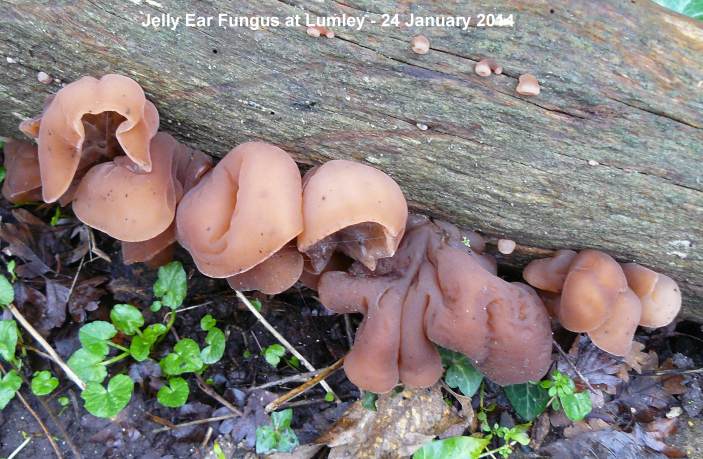
Daffodils were just
starting to open beside the road at the top of the
hill past Lumley Mill. I walked along a very muddy
Mill Lane to Westbourne. I happened to meet up with
John Barker who is the owner of the fields now called
Mill Meadow Farm to the west of the lane with the
Alpacas.
Green
Sandpipers
I was pleased to learn
from John that Green Sandpipers, that I used to see
regularly along the River Ems in the early 1990s when
I lived in Westbourne Avenue, were still present. In
fact, he told me he had seen two this morning along
the river. The one that Chris Oakley saw on the
attenuation pond on the Hampshire Farm site on Jan 11
might well have been one of these. John hs also seen
Snipe on the fields, although not this winter. I also
used to put Snipe up during my winter surveys in this
area.
Here is a nice photo
of a Green Sandpiper feeding. However, you can rarely
get this close as it is a nervous bird and usually
flies off in a zig-zag flight calling hysterically
with a pure white rump showing.
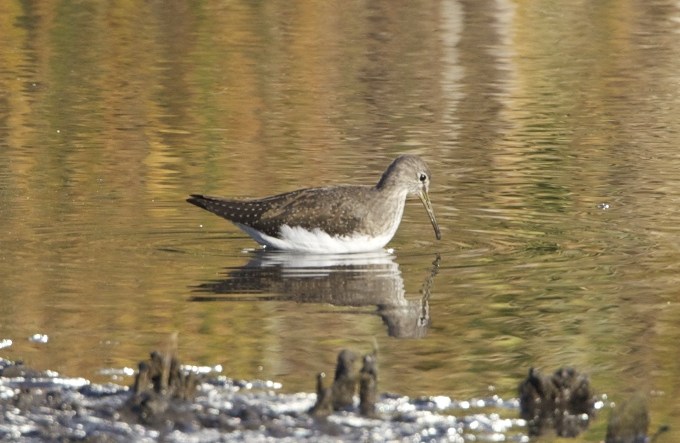
We are very fortunate
to have Green Sandpipers in Emsworth as they are
scarce winter visitors in Britain with only a few
recorded by the local ornithological societies. Most
of them winter in the Mediterranean basin and Africa
and pass over us on their way to and from their
breeding grounds in Scandinavia and Northern Europe.
Prinsted
Romney Turner was at
Prinsted today. She said the promise of sun soon
disappeared and it got very windy, so she had to get
down behind the sea wall most of the time. However,
she did get a good view of a flock of Brent Geese
feeding on the point field along with a few Curlews.
Safety in numbers and the field was obviously
providing plenty of food for all. There were also
Oystercatchers in the fields all huddled against the
wind on the point by the sluice gate as the tide was
receding.
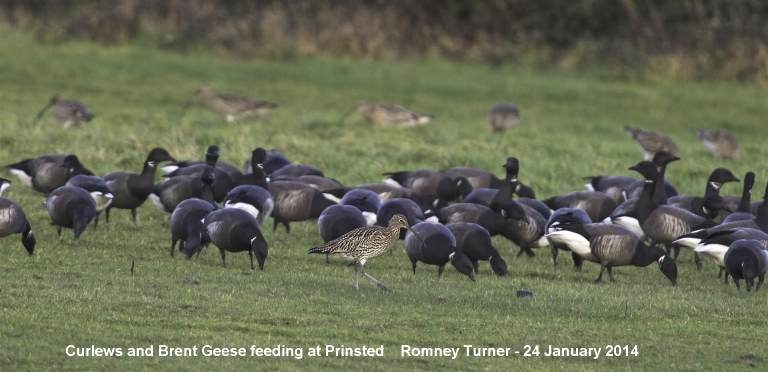
THURSDAY
JANUARY 23 - 2014
Brook
Meadow
Maurice Lillie walks
out early and as a consequence gets some great
atmospheric photos as dawn is breaking. Here is a
beauty showing the north meadow shrouded in morning
mist with a touch of frost on the grass.
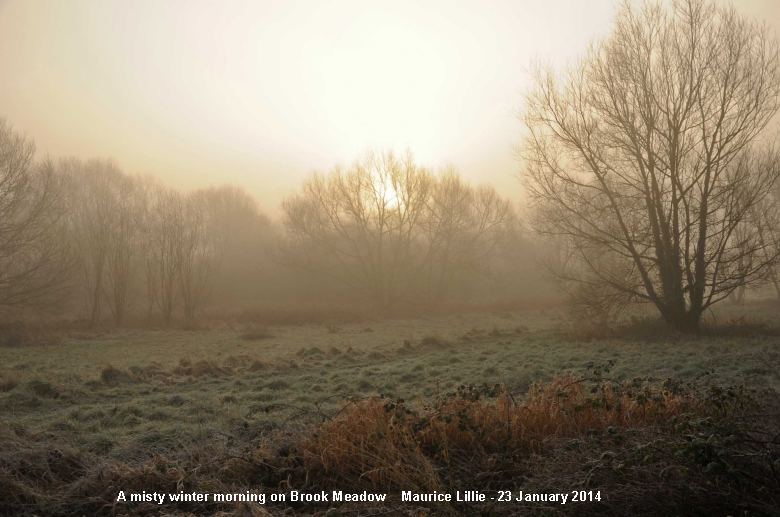
John Arnott heard the
first Chaffinch song of the year on Brook
Meadow yesterday. It came from the riverside (!) trees
in the South Meadow. He says, as usual at this time of
year, it wasn't the full confident rollicking
rendition but clearly recognisable none the less.
Ralph Hollins has already heard Chaffinch song in
Havant on Jan 14.
Malcolm Phillips was
also on Brook Meadow yesterday when he spotted this
Robin riding on a log on the swollen river.
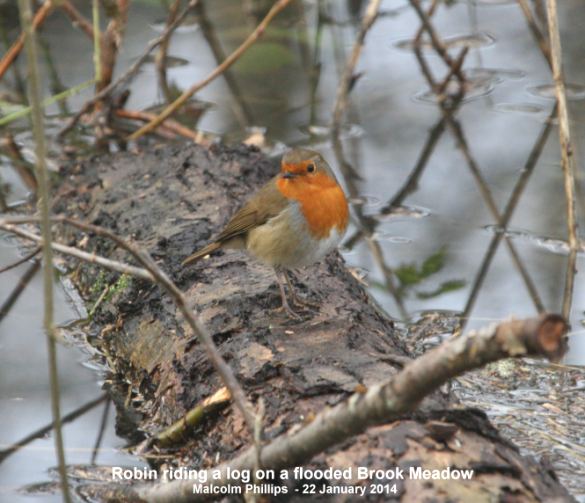
Malcolm also saw this
cluster of fungi growing on an old tree stump near the
south bridge. I think they could be Sulphur
Tuft (Hypholoma fasiculare) which are
fairly common on dead wood throughout the year.
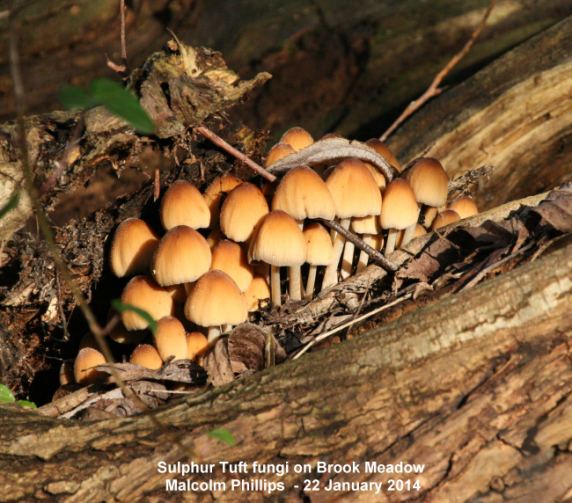
Garden
Blackcap
Graham Petrie had his
first sighting of the year of a male Blackcap on his
garden feeders. Graham is hoping a female will join
him, but no sign as yet.
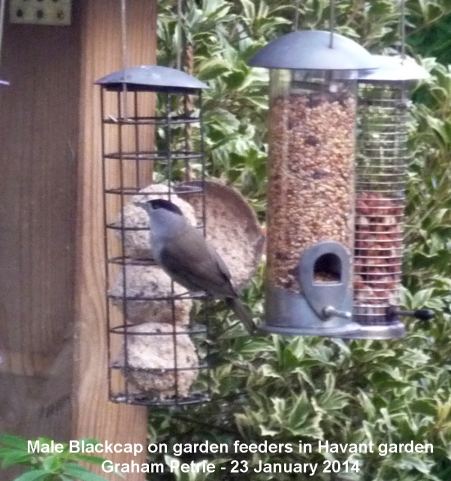
This is, as far as I
am aware, the first garden Blackcap reported in the
local area. Last winter, which was much colder than
this one, I had a male and a female Blackcap in my
garden in early January and also had reports of them
from Patrick Murphy and Caroline French in their
gardens. Blackcaps are, of course, regular winter
visitors to garden bird feeding stations, migrants
from the Continent. They are fairly liberal eaters,
but favour fat balls, apples and sponge cake!
Astonishing
Starling display
I have only just come
across a film of the most spectacular Starling display
I have ever seen. It was made in November 2011 by
Sophie Windsor Clive and Liberty Smith, independent
filmmakers based in London. They stumbled across this
amazing natural phenomenon during a canoe ride to an
island on Lough Derg, the last of the three largest
lakes on the River Shannon in Ireland. Here is a
YouTube link to their film . . . http://www.youtube.com/watch?v=iRNqhi2ka9k
I recall as a young
lad living near Birmingham seeing the sky darken as
masses of Starlings made their way to the city centre.
I don't think they still do that.
As an aside, I read
that a breeding pair of White-tailed Eagles nested on
an island in Lough Derg in 2012. This marked a great
success for the Irish reintroduction programme which
started in the summer of 2007.
Review
of the ringing session on Thorney Island - 18 January
2014
I am very grateful to
Pete Potts for permission to publish his report of
this very successful bird ringing session that I was
fortunate to attend. My own report with photos that I
took at the time can be seen on the blog entry for
January 18.
Report by Pete
Potts
"A big thank you to
all that helped with the catch at Thorney on Saturday
in case you haven't heard we achieved our objective!
Having set a narrow net with the help of the CHC
rangers Keith & Georgie on Friday afternoon in a
gap in the weather we assembled again before dawn and
set a second narrow net adjacent to the first. We were
all set up and out of the way by c.9am. The first
Greenshanks came in on schedule around 9:30 (sorry
forget when exactly). Soon a group gathered reaching a
max of I recall 14 birds, plus a Spotted Redshank and
a couple of Redshanks and briefly 10 Lapwings and an
inquisitive pair of Greylag Geese! The Greenshanks all
came in from the west, some at considerable height
calling, then dropped down to join the gathering
roost. I could see that at least two of them were our
geolocator tagged birds but at that range the
combinations were impossible to read the colour-ring
combos for certain- I was observing from the seawall
looking east back down the deeps c.500m to the net
set.
The Greenshanks
gathered on the corner of the deeps in the second net
that we had set that morning but it was difficult to
tell how close they were to the junction of the two
nets - worryingly close it seemed. at one stage I
thought ok let's fire both nets catch the pair of
geese in one and the waders in the other then for no
apparent reason all the birds lifted and for a few
frustrating moments vanished but then they returned
and thanks to one late comer that had turned up and
landed in front of the second net the flock joined it
and the pair of Greylags!
The birds seemed jumpy
but it was impossible to fire with a gander walking
about on the edge of safety neck held high - it didn't
like the cannons - as soon as it turned and got close
to the edge of the deeps we fired. I had decided not
to wait for the full complement of 16-18 Greenshanks
seen in recent days on the recees as we knew we had
most of them with at least 2 tagged birds and I
couldn't risk losing them all. Added to that c.200
Redshanks were due to join the roost imminently which
would have forced the Greenshanks elsewhere i.e. out
of the catching area and we couldn't deal with 200
Redshanks when trying to sort out loggers and with a
relatively inexperienced team.
The team having been
waiting by a pill box, c.150m+ away, dashed to the
nets as is tradition (and need) and were able to
quickly lift the small catch from behind onto the
banks of the deeps for extraction. We caught 19 birds:
13 Greenshanks, 4 Redshanks, 1 Spotted Redshank and a
Greylag Goose! A nice mixture and all of the birds
that were in front of the net when we fired! The net
was set 6m back from the water's edge - the narrow net
which goes out 8m was on 2m jumps so adequately sailed
over the roosting birds.
Here
is Pete and the team ringing the birds behind The
Stables
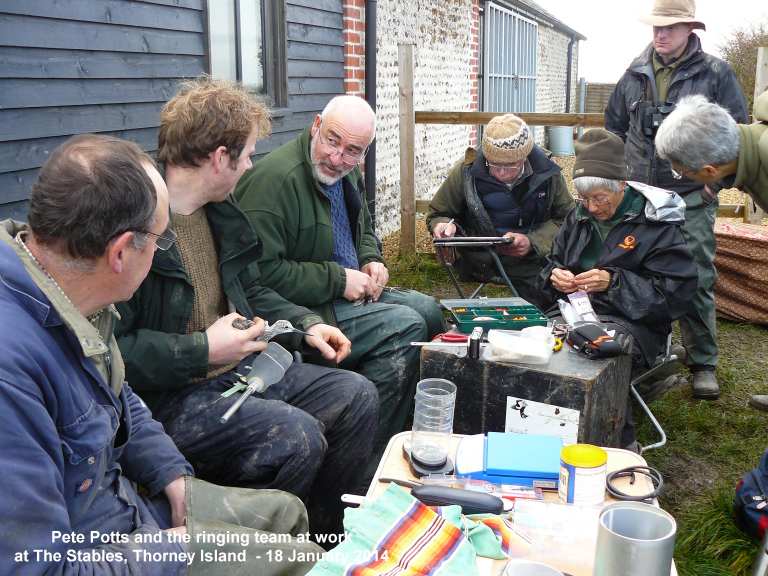
The 13 Greenshanks
incredibly included 5 retraps - and to our amazement
and delight the 3 Greenshanks that we tagged with
light sensitive loggers (geolocators) in March 2013 -
so in theory the loggers will tell us where they went
to breed.. plus one of the two that we tagged with a
logger in September (RGYY). The 3 tags were removed
for data downloading and replaced with fresh tags. All
the new birds were also fitted with tags as was the
one re-trapped (a colour-ringed bird and known
winterer YNYY). We await initial results from the tags
with impatience! How very exciting. This is ground
breaking stuff as it has not been done before with
Greenshanks on the wintering grounds and only a few
breeding birds in Scotland have so far been tagged
with geolcators- nowhere else in the world as far as
we know have Greenshanks been tagged in this way. So
fitting for the Farlington Ringing Group (FRG) to be
doing this work as the Greenshank has long been the
group's logo since the FRG inception in the late
1960s.
The Spotted Redshank
was a real bonus our second to be caught in "recent
years" and is now colour-ringed - the other one was
seen in Sweden. Very few are ringed in the British
Isles these days - Mark tells me just one in 2012..
and to think that in the early 1990s we turned down a
flock of 30 spotshanks while waiting for the
Greenshanks roost to develop on the scrape at FM!
The
newly ringed Spotted Redshank W+GR
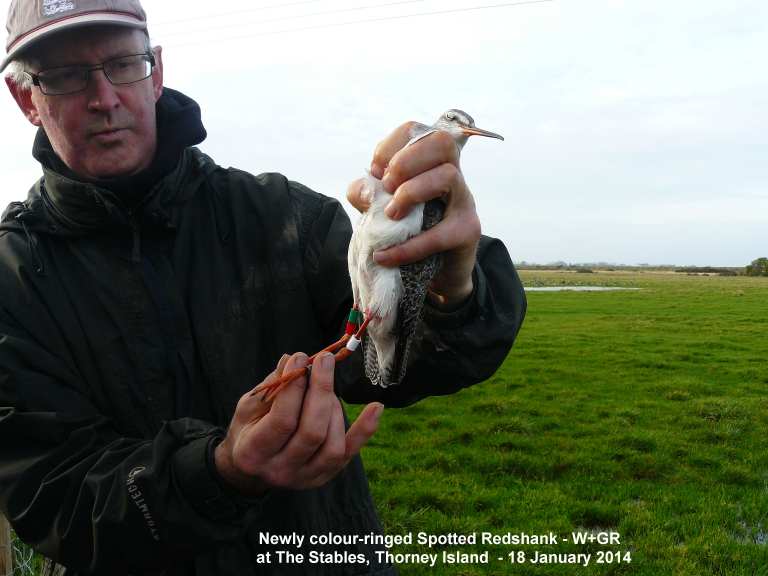
The 4 Redshanks were
also colour-ringed, the first to be marked in this way
in Chichester Harbour - a project Ed and I are
developing looking at interchange between roost sites
around the harbours - these follow c.50 colour-marked
at Farlington in September. Next weekend (details to
follow ASAP) we plan to colour-mark c.25-50 Redshanks
at the Kench, Hayling on the falling tide - there have
been up to 120 roosting there/Sinah this winter which
is more than in recent years. Initial observations
show that 3-4 of the shanks col-ringed at Farlington
in Sept are now roosting/feeding around the Kench at
the bottom of the harbour. Early days and all very
interesting. Josh Nightingale is maintaining the new
database for FRG. One has been seen on the Isle of
Wight but no others sightings so far outside the 2
eastern harbours."
Pete
and myself with the newly ringed Spotted Redshank
It turned out not to be the regular Nore Barn
bird
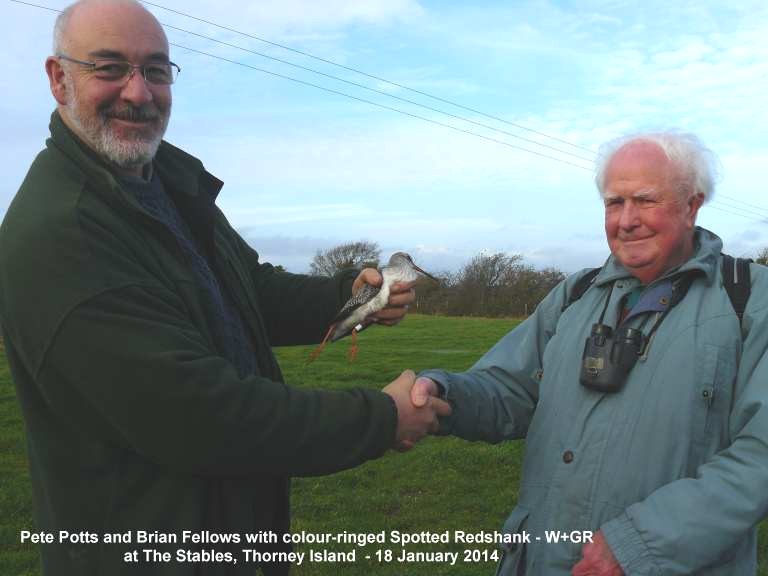
See
January 18 for more photos
WEDNESDAY
JANUARY 22 - 2014
River
Ems flood news
I had an e-mail from
Pam Phillips this morning to say that the River Ems
was higher than ever on Brook Meadow after last
night's rain. So, I donned my wellies and went over to
have a look for myself. The river was rushing through
the tunnel under the railway and was lapping against
the black sand bags in the north-east corner, but not
quite over topping them. This was as high as I have
ever seen the river.
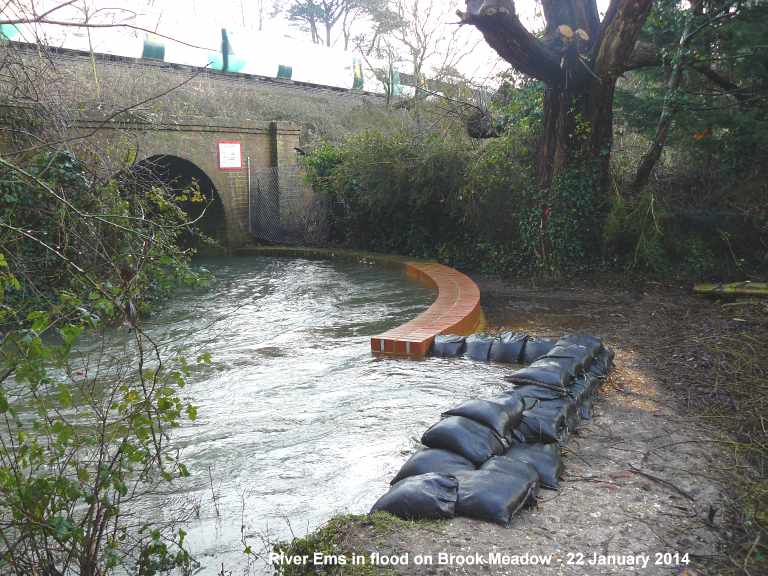
The north meadow was
awash, but maybe from the rain and the high water
table rather than the river. The S-bend had virtually
disappeared with the river cutting through the bend.
The river was cascading over the top of the sluice
gate into the south meadow - now operating in its
official capacity as a balancing pond. The south
meadow was virtually a lake with tall vegetation
sticking up above the water level.
Here
is one of the Ash trees near the causeway decorated
with hanging keys
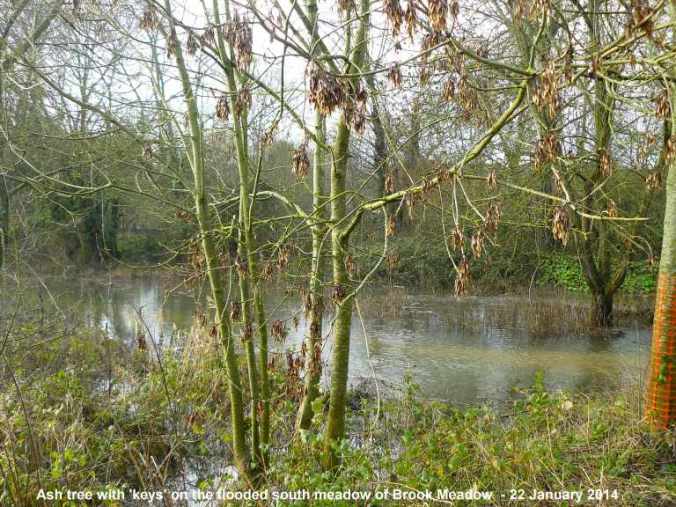
Water was rushing out
of the overflow from the south meadow into Peter Pond,
but this channel is not large enough to keep the keep
the level constant. The water was up to the top of the
bund around the garden of Gooseberry Cottage, but not
going over. The level of the water in the south meadow
was just below the Nature Reserve sign on the
signcase. The river in Palmer's Road Copse is close to
the top of bund between it and the south meadow. I
wonder what effect this flooding will have upon the
wildlife?
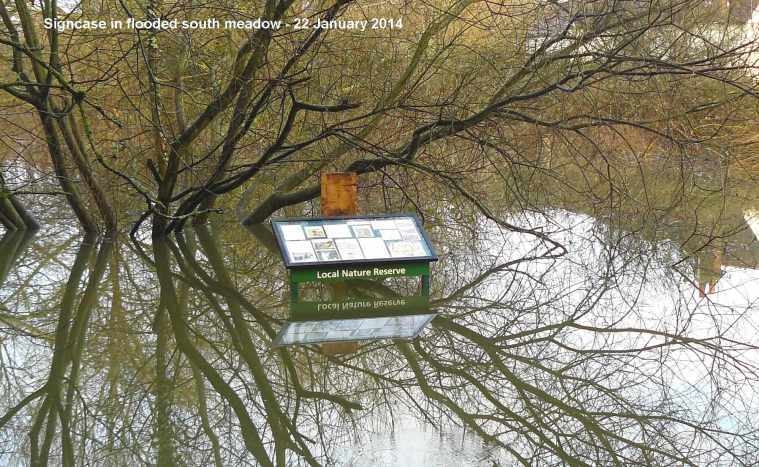
Worse
is to come?
Chris Oakley tried to
drive to Petersfield this morning, taking the route
through West Marden and Compton. He said, the valley
was like one continuous lake with water gushing off
the fields into heavily flooded roads. He was stopped
just this side of West Marden by an AA patrol who told
him that the road ahead was flooded up to four feet
deep. Chris pointed out that all this water has only
one way to go, down the River Ems, so the situation is
likely to get worse before it gets better in Emsworth.
More
flood photos are on the Brook Meadow web site at . .
. http://www.brook-meadow.hampshire.org.uk/bm-diary-2014a.html
But
spring is on the way!
Despite the flooding,
there was a real feel of spring in the air this
morning, the sun was shining and the birds singing
brightly all around the meadow. It was good to hear
Robins, Wren, Dunnock and Great Tit, plus two Song
Thrushes, one from the east side of the north meadow
and one from Palmer's Road Copse. What great voices
these birds have. Fresh leaves of Hairy Garlic are now
showing well along the path behind Lillywhite's
Garage, where the Sweet Violet flowers now number over
20.
Peter
Pond is looking good with Gooseberry Cottage in the
background
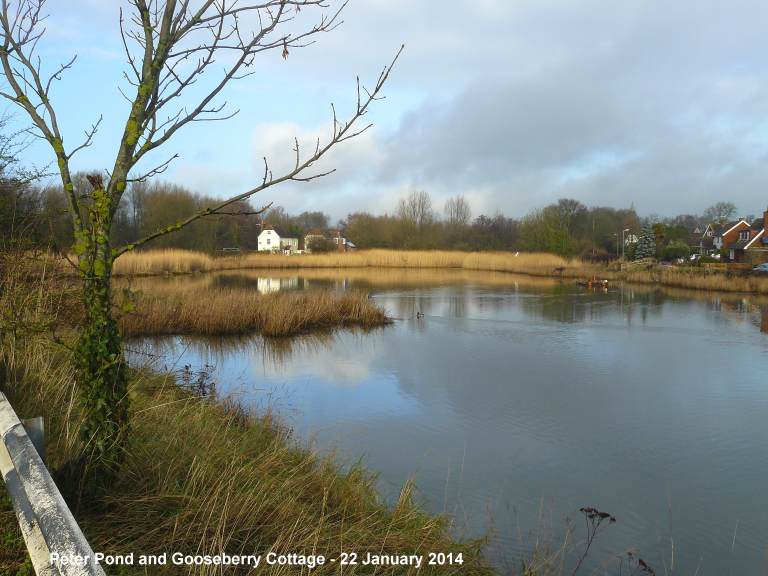
Buff-tail
Bumblebee
Chris Oakley got this
image of a Buff-tail Bumblebee (Bombus
terrestris) feeding on one of the flowering Gorse
bushes on the east side of Slipper Millpond this
afternoon. This was our first Bumblebee of 2014,
though I did see some in December 2013 on the Ivy
flowers at the end of Warblington Road. Bryan Pinchen
has alerted us to expect to see B. terrestris
bumblebees in mild winters. Queens start nesting in
the autumn and, if the weather is mild, continue
throughout the winter producing workers and later,
males and new queens. This is probably a worker.
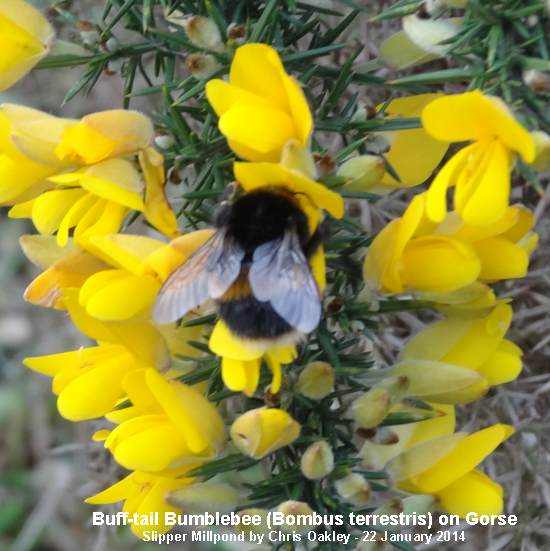
Buddleja
seedheads
Tony Davis, Ralph
Hollins, Martin Hampton and Daniel Hoare all responded
to my request for help in identifying the seedheads
that the female House Sparrow was feeding on in
yesterday's blog. They all agreed it was Buddleja.
Tony added that the seeds of this plant were very
popular with Goldfinches (feeding on the bush) and
Chaffinches (feeding on the ground below the bush) in
his garden last winter, which is a good reason not to
dead-head in the autumn! Good advice. They are also
very attractive as they are.
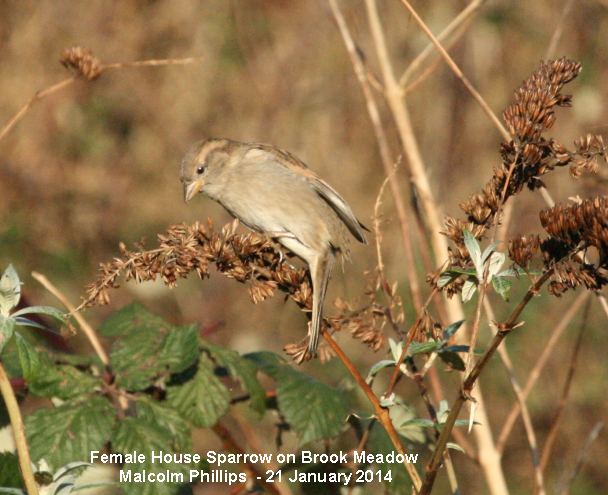
Dead
Guillemot
Tony Davis also noted
that the dead Guillemot found by Chris Oakley on
Hayling beach on Jan 16 was probably the same bird
that he saw. Tony says, the bird had a ring on its leg
which he removed and sent to the BTO for
identification. "The ring was very 'fresh and shiny' -
most unlike what I would expect from something that
has been in sea water for a while - and I fear that it
will turn out to be a recently released rehabilitated
bird (which perhaps wasn't rehabilitated enough! Time
will tell."
TUESDAY
JANUARY 21 - 2014
Brook
Meadow
I had a walk through
Brook Meadow to Slipper Millpond this morning. The
River Ems is still running very high and the water is
lapping at the base of the line of black sandbags in
the north-east corner, but not going over. Water is
still rushing over the sluice gate into the south
meadow, though this is no more flooded than over the
past few days. The plastic fencing the Environment
Agency erected across the top of the steps down to the
south meadow is still there. However, the fence had
been removed from the south gate entrance and the
flood sign has been damaged by kicking. The fence at
the entrance to the Palmer's Road Copse path has also
gone as has the cones, one of which was in the river.
Clearly, the work of the local lads.
Birds singing included
Robin, Dunnock, Great Tit and Song Thrush. A Grey
Wagtail was hunting around the reeds in the centre
of the river in front of the observation fence. This
is the best photo I could get of this constantly
moving bird.
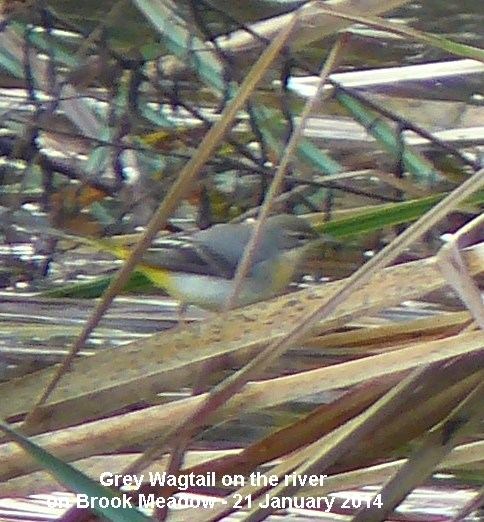
Malcolm Phillips went
around the meadow and got this rather nice image of a
female House Sparrow in the large bramble patch
in the north west corner of the meadow. Can anyone
help with the plant she is feeding from. I just can't
think what it is at present. A flock of House Sparrows
regularly come over to feed on Brook Meadow from the
gardens at the end of Seagull Lane.

Robin
pair
We had a pair of
Robins in the garden this morning for the first time
this winter. Although this is not particularly early,
as pairing can take place by the middle of December,
it is still about two months before the birds actually
nest. Most other song birds pair up in the spring,
with the exception of Blackbirds and Starlings which
pair in late autumn (David Lack: The Life of the
Robin).
Water
Rail at Fishbourne
Roy Hay got this photo
of a Water Rail in the stream at Fishbourne Meadows
today. I think the bird we had on Brook Meadow in
early December has gone.
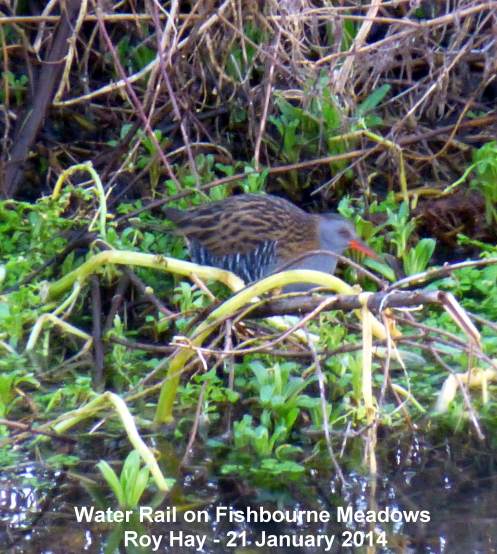
Seaweed
identification
John Arnott came to
our rescue by identifying several of the seaweeds
collected yesterday from Hayling beach by Chris
Oakley. Here is John's annotated version of Chris's
photo.
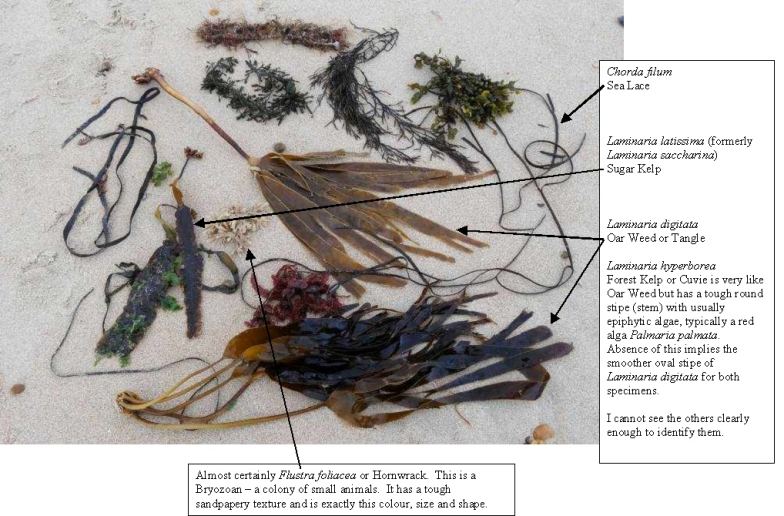
The seaweeds
identified by John in the photo are:
Chorda filum
- Sea Lace.
Laminaria latissima (formerly
Laminaria saccharina) - Sugar Kelp
Laminaria digitata - Oar Weed or Tangle.
Laminaria hyperborea - Forest Kelp or Cuvie is
very like Oar Weed but has a tough round stipe (stem)
with usually epiphytic algae, typically a red alga
Palmaria palmata. Absence of this implies the
smoother oval stipe of Laminaria digitata for
both specimens.
Almost certainly
Flustra foliacea - Hornwrack. This is a
Bryozoan - a colony of small animals. It has a tough
sandpapery texture and is exactly this colour, size
and shape.
John says "A couple of
the others look like possible Bladder Wrack
(Fucus vesiculosus) and Sea Oak
(Halidrys siliquosa) but I cannot make them out
clearly in their tangled state and would need closer
views (magnifying the image doesn't help). The red one
might be Dulse Palmaria palmata but
again difficult to tell in its tangled
state.
Ralph Hollins was also
prompted to have a crack at the seaweeds. He
identified the two examples of Oarweed (Laminaria
digitata). However, the one that interested him most
was the one that curved down from the top of the photo
to almost touch the central Oarweed. Ralph thinks it
is a small section of Wireweed (Sargassum
muticum) which he says was first identified in
Britain in 1973 by Bill Farnham of Portsmouth
Polytechnic (now University) - see . . .
http://www.seaweed.ie/sargassum/
Ralph adds that in the 1970s and 80s this weed was
thought to be unstoppable and would clog up the water
all round Britain making leisure sailing impossible.
MONDAY
JANUARY 20 - 2014
EMSWORTH
HARBOUR
Nore
Barn
I took the bike out
with the scope down to the harbour this morning mainly
to look for the ringed birds from Saturday's ringing
on Thorney. There was nothing much in the main harbour
but the situation changed dramatically when I got to
Nore Barn. The Spotted Redshank (without rings) was
already present in the stream when I arrived at about
10:30 along with a Little Egret. They were joined by
an unringed Greenshank at about 11:15.
Two
Spotted Redshanks
This is when I met up
with Peter Milinets-Raby and his young son, Alexandre.
We chatted for a while and watched the birds when
Peter noticed a second Spotted Redshank further out in
the channel. In a few minutes it had made its way into
the stream to feed along with the regular Spotted
Redshank, which did a bit of chasing to begin with,
but soon came to tolerate the second bird's close
presence.
Here
are the two Spotted Redshanks feeding with the
Greenshank
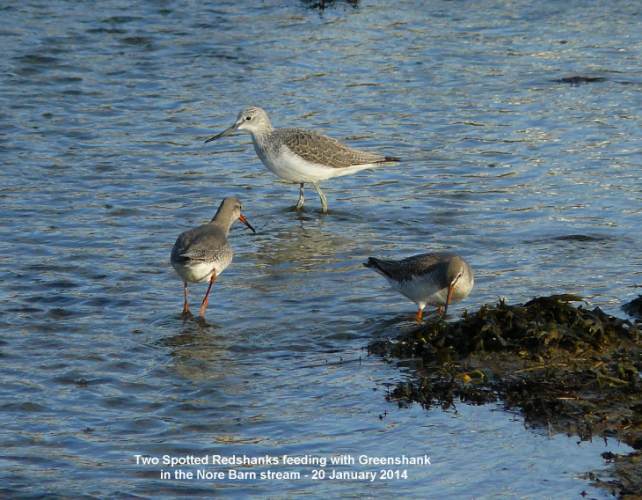
It was immediately
clear that this second Spotted Redshank was also not
ringed, which meant that the Spotted Redshank ringed
by Pete Potts on Saturday on Thorney was not either of
these two birds. This means we have at least four
local Spotted Redshanks, ie the two ringed birds G+GY
(ringed in Oct 2008) and G+GR (ringed on 18 Jan 2014)
and the two in the stream today.
For an hour or so
Peter and I had the great pleasure and privilege to
watch these four iconic birds actively feeding in the
stream, often in close proximity to each other, two
Spotted Redshanks, a Greenshank and a Little Egret.
Fantastic! I also got some nice photos.
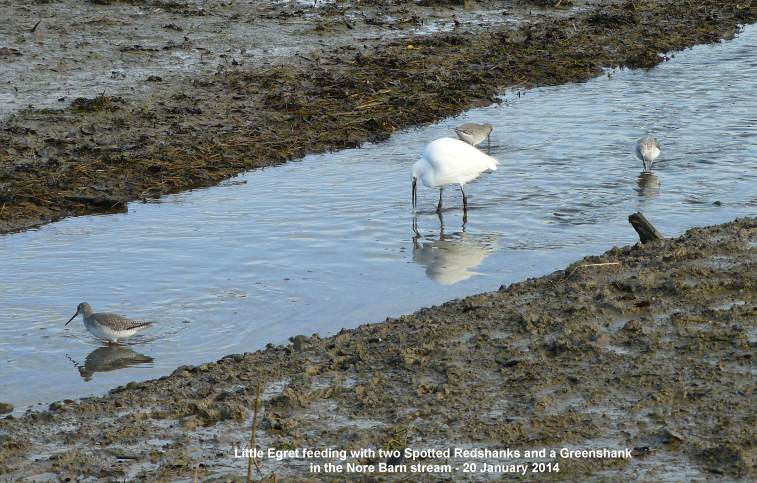
and
Peter got one of me!
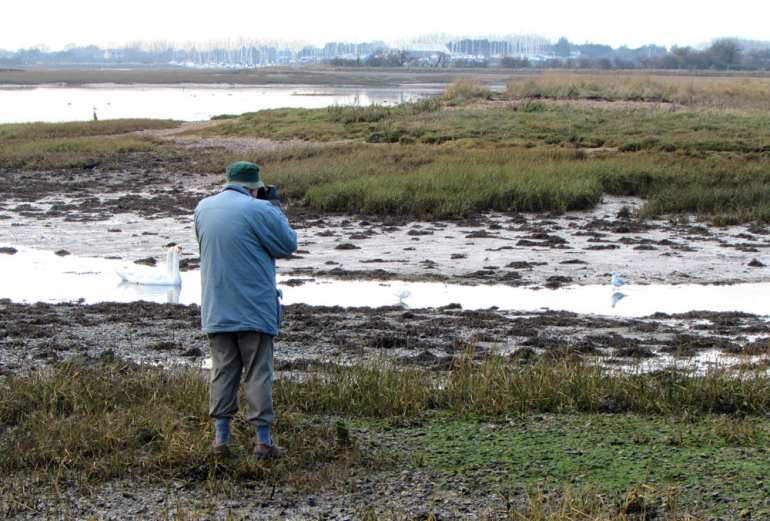
Where
do they roost?
The fact the Spotted
Redshanks that were at Nore Barn today were not caught
on Thorney on Saturday clearly suggests they do not
roost on Thorney Island, but possibly on the
saltmarshes in Emsworth Harbour. Today, after they had
finished feeding in the stream the two Spotted
Redshanks settled down on the edge of the saltmarshes
to the west of the stream where they were when I left
at about 12:30.
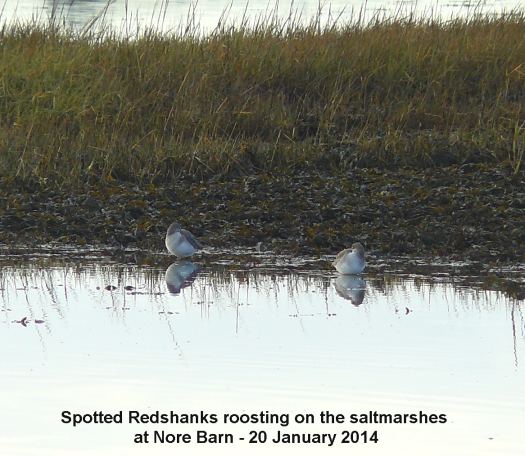
The Greenshank did not
roost with the Spotted Redshanks, but went elsewhere.
The Little Egret was still feeding in the upper stream
near the bridge when I left. I had seen it catching
small fish which seemed to be abundant in the stream.
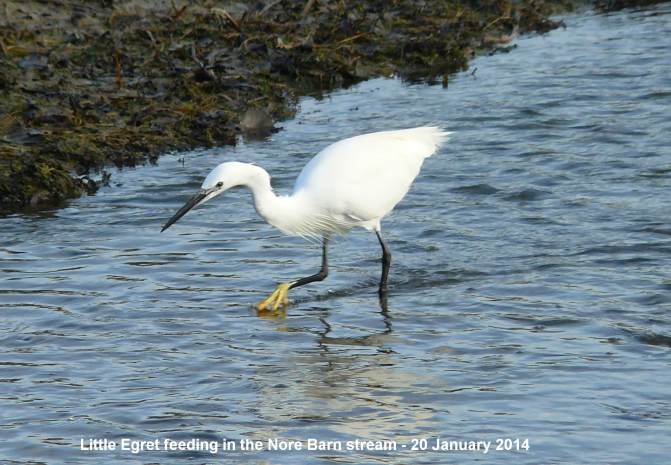
Finally,
a nice sky view taken by Peter Milinets-Raby from Nore
Barn
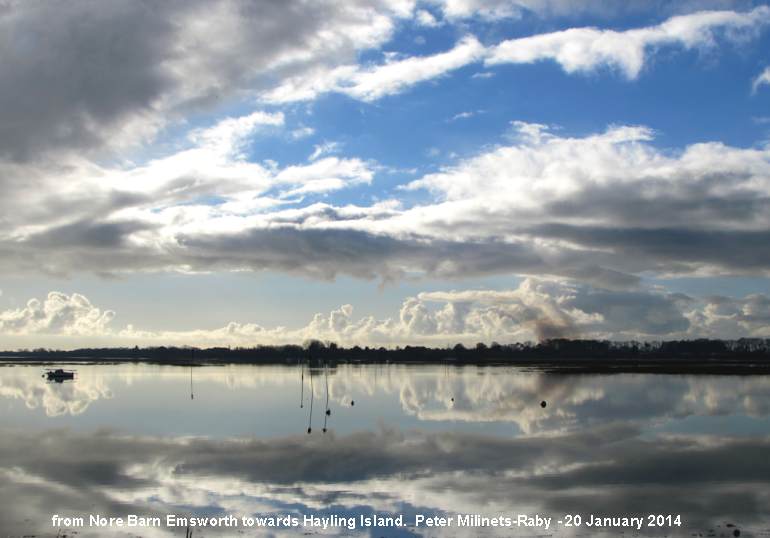
BROOK
MEADOW
Maurice Lillie made a
couple of interesting observations today. Firstly, he
noted that several flooded parts of the meadow have
what look like mole holes. But, more interesting is
that in some holes water is draining into the hole and
in others water is bubbling out. This is water finding
its own level, but it does look odd.
The other was a fairly
common bracket fungus growing on a log on the right
hand side of the Seagull Lane patch towards the
tunnel. This is Many-zoned Polypore (Coriolus
versicolor) which is distinctive for its concentric
zones of black, grey and brown with a pale margin on
its upper side.
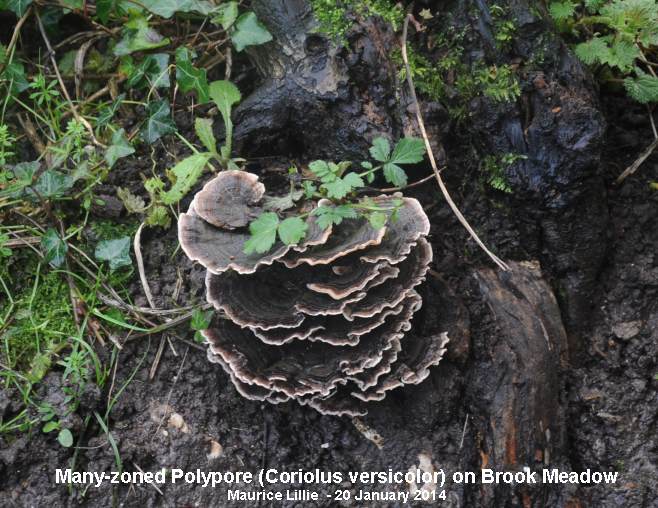
HAYLING
BEACH
Chris Oakley was down
on Hayling beach again this morning where he
discovered a large variety of fascinating seaweeds. He
collected this lot of 12 different types in a matter
of few yards. Can anyone identify the
species?
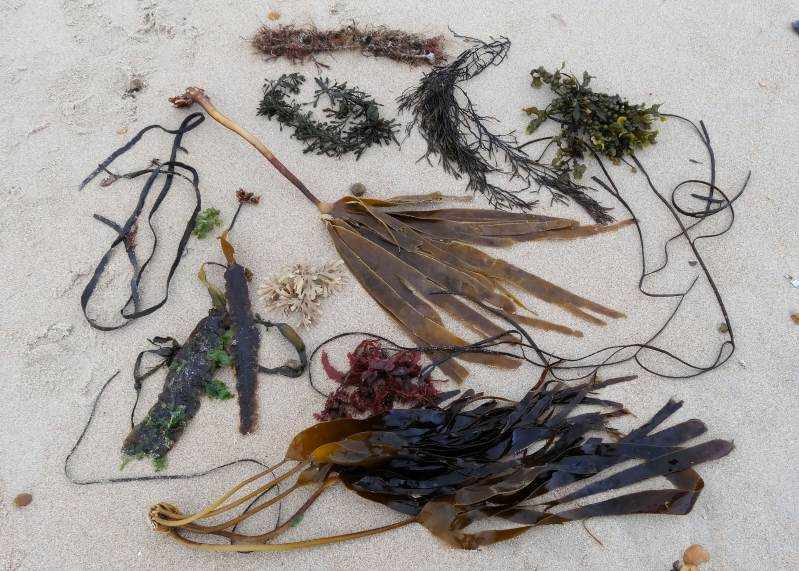
SATURDAY
JANUARY 18 - 2014
FLOODING
NEWS
River
Ems
Basically, nothing new
from yesterday. The river level remains very high on
Brook Meadow, but no higher than it was yesterday.
Water was still cascading over the sluice gate into
the south meadow. I saw people attempt to walk through
the south meadow, but they did not get very far as the
water is at waist height at the south end.
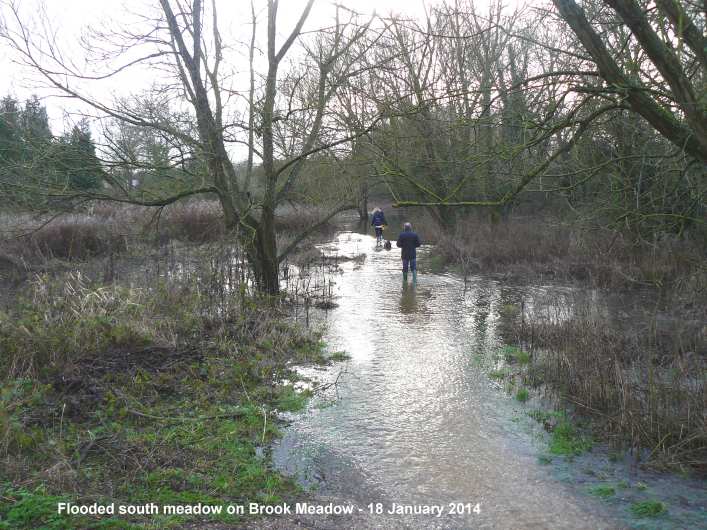
More
news and photos is on the Brook Meadow web site
at . . .
http://www.brook-meadow.hampshire.org.uk/bm-diary-2014a.html
BIRD RINGING
I had a phone call
from Anne de Potier this morning inviting me to come
down to The Stables on Thorney Island where Pete Potts
and his bird ringing team had made an excellent catch
on The Deeps. The birds caught included 15 Greenshank
(including all three of the geo-tagged ones) and a
Spotted Redshank, which Anne thought could be the one
that I have been watching at Nore Barn for the past 10
years. I rushed down there just as Pete was putting
the colour rings on the Spotted Redshank; the rings
used were W+GR (white on the left taibia and green
over red on the righ tibia). It was great to see the
bird at such close quarters. But was it the Nore Barn
bird? Sadly, not as I explain below. Meanwhile, here
are a few photos I took of the ringers and the birds.
Pete
and other members of the team. Not all are shown here.

Close-up
of Pete with Ruth Croger putting rings on the Spotted
Redshank
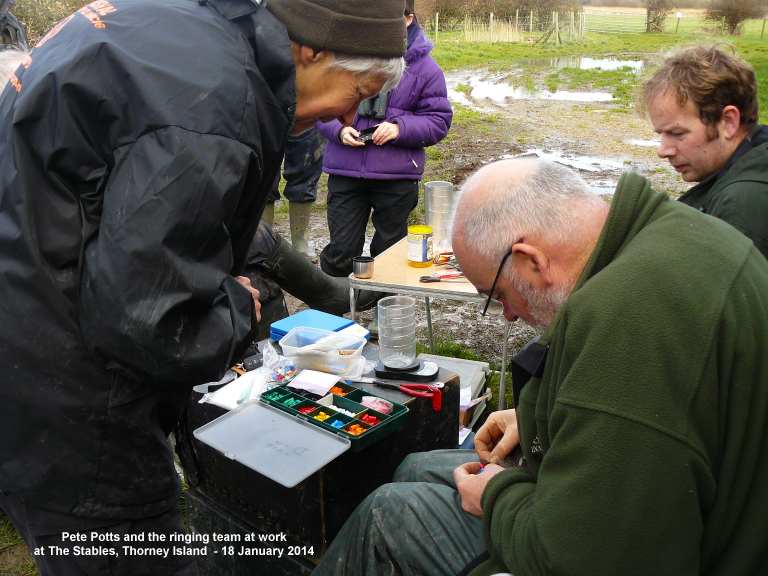
Pete
discussing features of the Spotted Redshank's wing
feathers
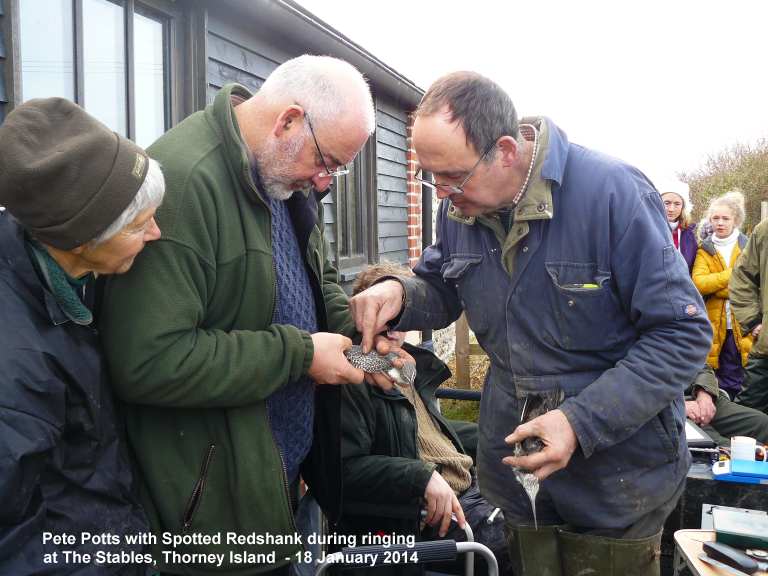
Close-up
of the Spotted Redshank with wing extended
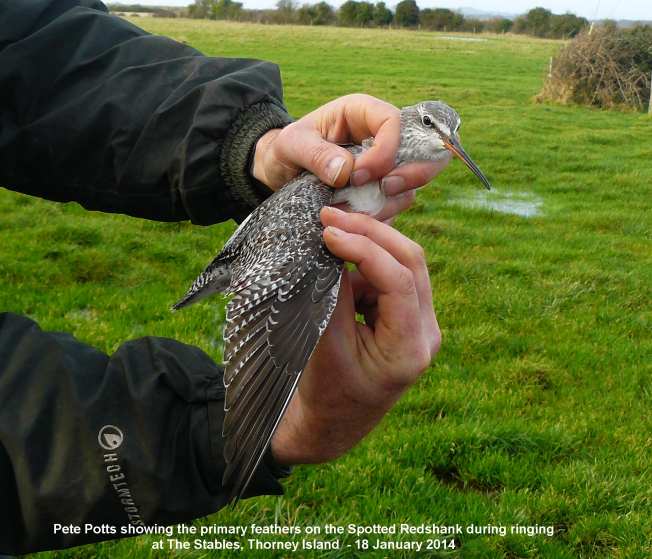
Spotted
Redshank with its new rings - W+GR

Pete
invited me to share a photo with the ringed Spotshank
just in case it was the Nore Barn bird

Finally,
the Spotted Redshank was released onto the field
behind the stables
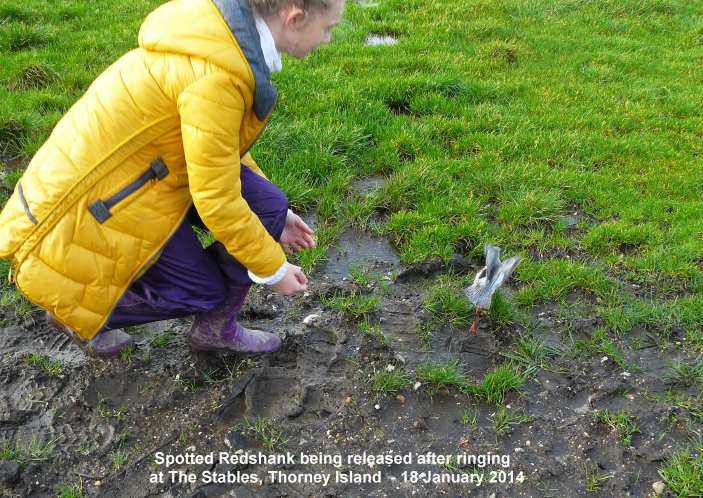
This
shows one of the geo tags attached to the upper blue
ring on the Greenshanks
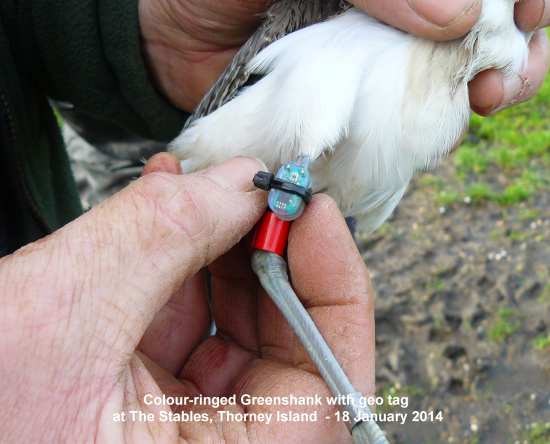
One of
the ringing team taking measurements of a Greenshank
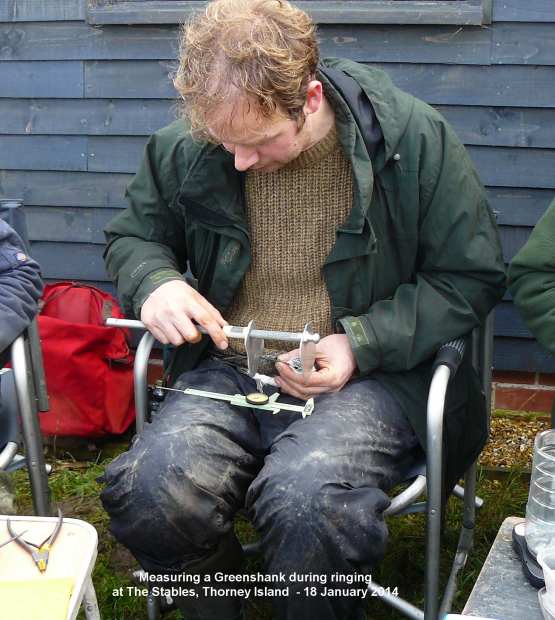
Finally,
a small flock of Brent Geese feeding on the field
behind The Stables
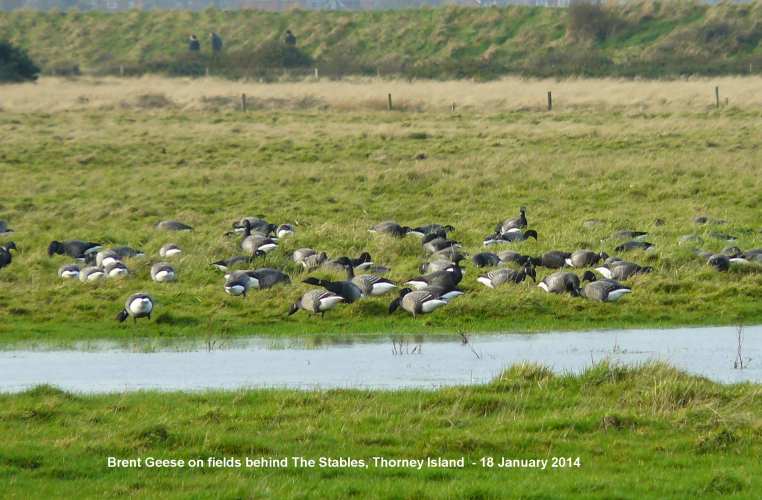
Which
Spotted Redshank?
I went over to Nore
Barn this afternoon about 3 hours after high water to
see if the Spotted Redshank would turn up. I stayed
for about 30 minutes watching the stream, but there
was no sign of it, or anything else in the stream.
Anne de Potier arrived as I was leaving to have a look
for the bird, but also she saw nothing. However, the
Havant Wildlife Group had their Saturday walk to Nore
Barn this morning, so I rang Caroline French to see if
they had seen the Spotted Redshank. Yes, they did at
about 10:10 (see Caroline's report below). I checked
with Anne and she told me the all birds were caught
this morning at 10am, which almost certainly means
that the ringed Spotted Redshank was not the one that
has been coming to Nore Barn over the years. However,
it might be its 'friend' which often turns up in the
stream, so we shall have to keep a look out for it.
Havant
Wildlife Group walk
Caroline French
reported on this morning's walk by the Havant Wildlife
Group to Nore Barn in Emsworth. "Six of us walked from
the Bridge Road car park, along the western side of
the town mill pond and along the shore as far as Nore
Barn Woods stream. It was rather cold and grey but dry
at least! The highlight of the morning was the
Spotted Redshank feeding in the stream at
10.10. There was no Greenshank in the stream but we
did think we caught sight of one flying from nearby on
the shore out towards the saltmarsh in the harbour,
but couldn't be sure. Other birds seen were: Mallard,
Little Grebe, Black-headed Gull, Mute Swan, Coot,
Dunnock, Woodpigeon, Goldfinch, Little Egret, Grey
Plover, Dunlin, Brent Goose, Oystercatcher, Curlew,
Redshank, Shelduck, Turnstone (30+), Pintail, Wigeon,
Teal, Carrion Crow, Herring Gull and Starling.
FRIDAY
JANUARY 17 - 2014
Flooding
of the River Ems
I was interested to
see the effects on the level of the River Ems through
Brook Meadow of the heavy overnight rain. The river
has been running exceptionally high for several days
and today it was even higher. The S-bend had almost
disappeared completely. The water was going right over
the sluice gate into the south meadow. I met two
Environment Agency workers who told me they had
removed the wooden struts from the sluice to prevent
the Ems flooding in the north-east corner, thus
putting the cottages in Lumley Road at risk. So, the
south meadow was now functioning in its official
capacity as a 'balancing pond'. **
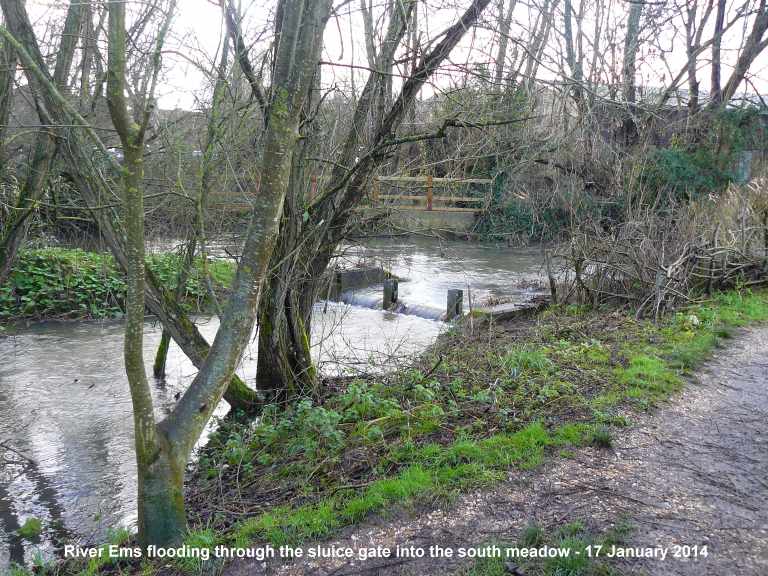
The south meadow was
not actually as deep as it was following the Christmas
Eve flooding, but I suspect the level is still rising.
Palmer's Road Copse was totally flooded.
I walked up to Lumley
Mill where the sluice gates were were fully open
allowing water to flow freely into the Lumley Stream,
which was a raging torrent, but not immediately
threatening the cottages along Lumley Road. I tried
walking a little way along the flooded path from the
mill towards Seagull Lane, but had to turn back as the
water was periously close to the top of my wellies. In
contrast, Gooseberry Cottage, which had suffered
severe flooding from the storms and the tidal surge
over the Christmas period, appeared to be unaffected.
More
photos on the Brook Meadow web site
at . . .
http://www.brook-meadow.hampshire.org.uk/bm-diary-2014a.html
Chris Oakley took this
picture of the River Ems raging under the bridge at
Westbourne. He compared it with a picture he took last
year and said it was about the same level, although
last year it was heavy with mud from the Hampshire
Farm development. At the moment the attenuation pond
on the Hampshire Farm site is nowhere near full so
that is unlikely to to be having any influence on the
water flow.
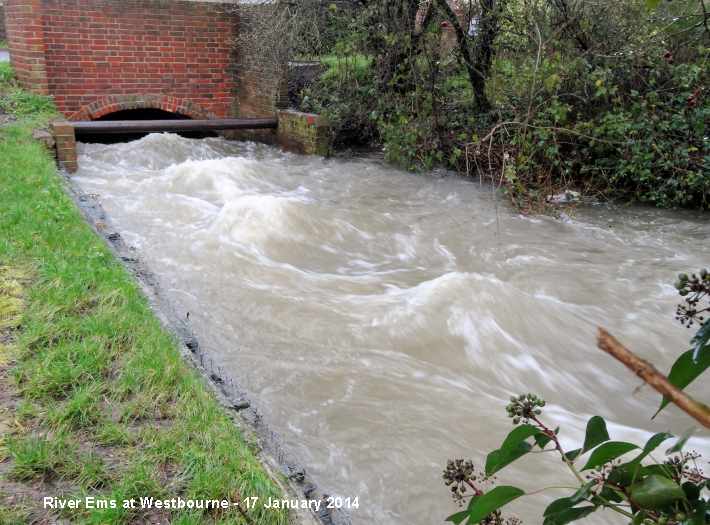
Other
observations
More Sweet Violets are
opening up on the south side of the path behind
Lillywhite's Garage near the tall brick wall. Cow
Parsley is still flowering on the causeway on Brook
Meadow. A Song Thrush was singing strongly from
Palmer's Road Copse.
For
earlier observations go to . . . January
1-16